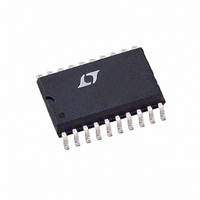LTC1289CCSW#TR Linear Technology, LTC1289CCSW#TR Datasheet - Page 19

LTC1289CCSW#TR
Manufacturer Part Number
LTC1289CCSW#TR
Description
IC DATA ACQ SYS 12BIT 3V 20SOIC
Manufacturer
Linear Technology
Type
Data Acquisition System (DAS)r
Datasheet
1.LTC1289CCN.pdf
(28 pages)
Specifications of LTC1289CCSW#TR
Resolution (bits)
12 b
Sampling Rate (per Second)
25k
Data Interface
Serial, Parallel
Voltage Supply Source
Dual ±
Voltage - Supply
3V
Operating Temperature
0°C ~ 70°C
Mounting Type
Surface Mount
Package / Case
20-SOIC (7.5mm Width)
Lead Free Status / RoHS Status
Contains lead / RoHS non-compliant
Available stocks
Company
Part Number
Manufacturer
Quantity
Price
A
pins on the package ends (DGND and CH0). Grounding
any unused inputs (especially the end pin, CH0) will also
reduce outside coupling into high source resistances.
4. Sample and Hold
Single-Ended Inputs
The LTC1289 provides a built-in sample and hold (S&H)
function for all signals acquired in the single-ended mode
(COM pin grounded). This sample and hold allows the
LTC1289 to convert rapidly varying signals (see typical
curve of S&H Acquisition Time vs Source Resistance). The
input voltage is sampled during the t
in Figure 10. The sampling interval begins after the fourth
MUX address bit is shifted in and continues during the
remainder of the data transfer. On the falling edge of the
final SCLK, the S&H goes into hold mode and the conver-
sion begins. The voltage will be held on either the 8th, 12th
or 16th falling edge of the SCLK depending on the word
length selected.
Differential Inputs
With differential inputs or when the COM pin is not tied to
ground, the A/D no longer converts just a single voltage
but rather the difference between two voltages. In these
cases, the voltage on the selected “+” input is still sampled
and held and therefore may be rapidly time varing just as
in single ended mode. However, the voltage on the se-
lected “–” input must remain constant and be free of noise
and ripple throughout the conversion time. Otherwise, the
differencing operation may not be performed accurately.
The conversion time is 52 ACLK cycles. Therefore, a
change in the “–” input voltage during this interval can
cause conversion errors. For a sinusoidal voltage on the
“–” input this error would be:
Where f(“–”) is the frequency of the “–” input voltage,
V
the ACLK. In most cases V
PEAK
PPLICATI
V
ERROR (MAX)
is its peak amplitude and f
= V
O
U
PEAK
S
× 2 × π × f(“–”) ×
ERROR
I FOR ATIO
U
will not be significant. For
ACLK
W
SMPL
is the frequency of
time as shown
f
ACLK
52
U
a 60Hz signal on the “–” input to generate a 1/4LSB error
(150µV) with the converter running at ACLK = 2MHz, its
peak value would have to be 15mV.
5. Reference Inputs
The voltage between the reference inputs of the LTC1289
defines the voltage span of the A/D converter. The refer-
ence inputs will have transient capacitive switching cur-
rents due to the switched capacitor conversion technique
(see Figure 14). During each bit test of the conversion
(every 4 ACLK cycles), a capacitive current spike will be
generated on the reference pins by the A/D. These current
spikes settle quickly and do not cause a problem. How-
ever, if slow settling circuitry is used to drive the reference
inputs, care must be taken to insure that transients caused
by these current spikes settle completely during each bit
test of the conversion.
When driving the reference inputs, two things should be
kept in mind:
1. Transients on the reference inputs caused by the
capacitive switching currents must settle completely
during each bit test (each 4 ACLK cycles). Figures 15
and 16 show examples of both adequate and poor
settling. Using a slower ACLK will allow more time for
the reference to settle. However, even at the maximum
ACLK rate of 2MHz most references and op amps can
be made to settle within the 2µs bit time. For example
an LT1019 used in the shunt mode with a 10µF bypass
capacitor will settle adequately. To minimize power an
LT1004-2.5 can be used with a 10µF bypass capacitor.
For lower value references the LT1004-1.2 with a 1µF
bypass capacitor can be used.
Figure 14. Reference Input Equivalent Circuit
R
V
OUT
REF
REF
REF
14
13
+
–
EVERY 4 ACLK CYCLES
R
ON
8pF – 40pF
LTC1289
LTC1289
LTC1289 AIF14
19
1289fb













